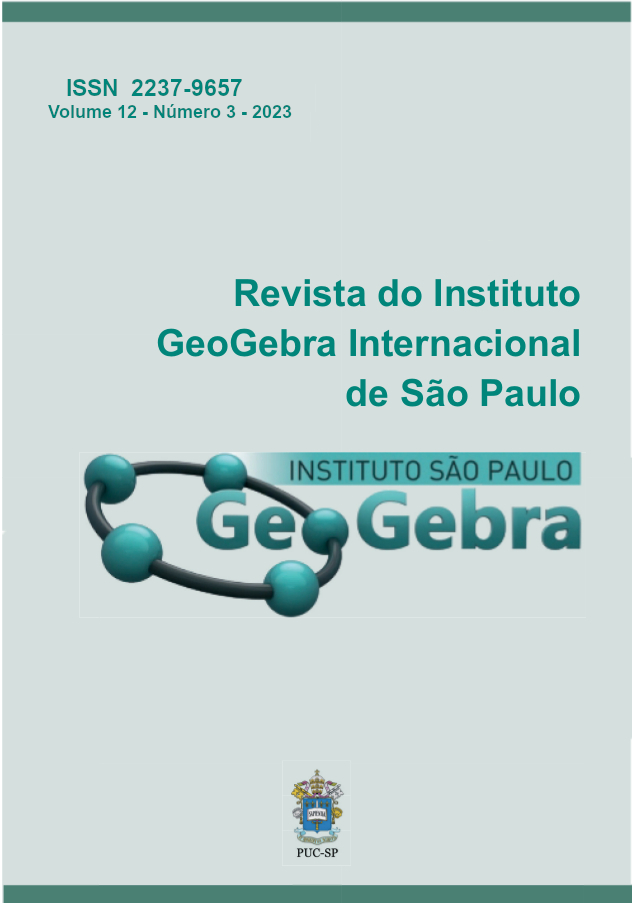Deaf students and the use of GeoGebra software in mathematics:
possibilities for understanding 2nd degree equations
DOI:
https://doi.org/10.23925/2237-9657.2023.v12i3p054-065Keywords:
Deaf, GeoGebra, MathematicsAbstract
ABSTRACT
This article is an excerpt from a dissertation that had deaf students and the use of GeoGebra software for understanding 2nd degree equations as its theme. The adopted methodology was qualitative, with the principles of a case study. Data collection took place through observations and was treated by dialectical analysis. The research was developed in a school for the deaf with a group of 9th grade of the Elementary School, in a bilingual way. There was familiarization with the GeoGebra software and the revision of the 1st degree equations, practical contextualization, and use of the software for the analysis of the graphs of the equations, in order to understand the concepts and application of the equations. The analysis showed that the methodology can be considered positive, meeting the objectives.Keywords: Deaf; GeoGebra; Mathematics.
References
BOGDAN, R. C.; BIKLEN, S. K. Qualitative Research for Education. An introduction to theory and methods. 5. ed. Boston: Allyn and Bacon, 1982.
BONGIOVANNI, V.; VISSOTO, O. R. L; LAUREANO, J. L. T. Matemática Vida: números, medidas e geometria. 8ª série. 6. ed. São Paulo: Ática, 1995.
BORBA, M. C.; SILVA, R. S.; GADANIDIS G. Fases das tecnologias digitais em Educação Matemática: sala de aula em movimento. Belo Horizonte: Autentica, 2016.
CAMPELLO, A. R. S. Aspectos da Visualidade na Educação de Surdos. 2008. Tese (Doutorado em Educação) - Universidade Federal de Santa Catarina, Florianópolis, 2008.
DUB - Escola Especial Professor Alfredo Dub. Disponível em: http://www.alfredodub.com.br/Home. Acesso em: 26 dez. 2017.
FERNANDES, E. David Ausubel e a Aprendizagem Significativa. Nova Escola, 2011. Disponível em: https://novaescola.org.br/conteudo/262/david-ausubel-e-a-aprendizagem-significativa. Acesso em: 08 jan. 2019.
INSTITUTO GEOGEBRA DE SÃO PAULO. Faculdade de Ciências exatas da PUC. Disponível em: http://www.youtube.com/user/GeoGebraChannel. Acesso em: 20 fev. 2023.
KENSKI, V. M. Tecnologias do Ensino Presencial e a Distância. 9. ed. Campinas: Papirus, 2012.
LADD, P. Understanding deaf culture: in search of Deafhood. Sydney: Multilingual Matters, 2013.
LÜDKE, M.; ANDRÉ, M. E. D. A. Pesquisa em Educação: abordagens qualitativas. 2 ed. Rio de Janeiro: E.P.U., 2015.
MINAYO, M. C. (org.). Pesquisa Social: teoria método e criatividade. Petrópolis: Vozes, 2002.
MOREIRA, M. A. Aprendizagem Significativa. Brasília: UNB, 1999.
MOROSINI, M. C.; FERNANDES, C. M. B. Estado do Conhecimento: conceitos, finalidades e interlocuções. Educação Por Escrito, Porto Alegre, 2014.
PIAGET, J. Biologia e conhecimento. Petrópolis: Vozes, 1973.
QUADROS, R. M. Educação de Surdos: a aquisição da linguagem. Porto Alegre: Artmed, 1997.
QUADROS, R. M.; KARNOP, L. B. Língua de sinais brasileira: estudos linguísticos. Porto Alegre: Artmed, 2004.
SKLIAR, C.; MASSONE, M. L; VEINBERG, S. El acesso de los ninos surdos al bilinguismo y al biculturalismo. Revista Infância e Aprendizagem, Madrid, n. 69/70, 1995.
SKUTNABB- KANGAS, T. O direito ao ensino médio da língua materna - a batata quente em instrumentos de direitos humanos. Anais do II Simpósio Internacional Mercator: Europa 2004: Um novo marco para todas as línguas? Disponível em: https://www.researchgate.net/publication/251811827_The_right_to_mother_tongue_medium_education_-_the_hot_potato_in_human_rights_instruments. Acesso em: 20 fev. 2019.
STROBEL, K. As Imagens do outro sobre a Cultura Surda. Florianópolis: Editora da UFSC, 2008.
Downloads
Published
How to Cite
Issue
Section
License
Copyright (c) 2023 Revista do Instituto GeoGebra Internacional de São Paulo

This work is licensed under a Creative Commons Attribution 4.0 International License.
Submission, processing, and publication of articles sent to the journal and registration of the DOI at Crossref is free of charge.
Authors retain their copyright and grant the journal the right of first publication of their article, which is simultaneously licensed under a Creative Commons - Attribution 4.0 International license CC BY that allows others to share the article by acknowledging its authorship and initial publication by the journal.
The GeoGebra journal encourages its authors to register their work with information and communication management systems aimed at researchers, such as Academia.edu, Mendeley, ResearchGate, etc.


 10.23925
10.23925
